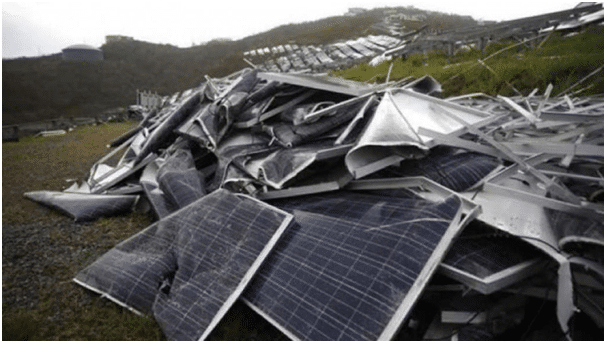Managing India’s Solar PV Problem
Context: There has in the last few years been a concerted push from policymakers in India to transition to a circular economy and to enable effective waste management. But waste management in the solar photovoltaic (PV) sector still lacks clear directives.
What is PV waste?
- Globally, India has the world’s fourth highest solar PV deployment. The installed solar capacity was nearly 62GW in November 2022.
- According to a 2016 report by the International Renewable Energy Agency, India could generate 50,000-3,25,000 tonnes of PV waste by 2030 and more than four million tonnes by 2050.
- India’s solar PV installations are dominated by crystalline silicon (c-Si) technology.
- A typical PV panel is made of c-Si modules (93%) and cadmium telluride thin-film modules (7%).
- A c-Si module mainly consists of a glass sheet, an aluminium frame, an encapsulant, a backsheet, copper wires, and silicon wafers. Silver, tin, and lead are used to make c-Si modules.
- The thin-film module is made of glass, encapsulant, and compound semiconductors.
Is this waste recycled?
- As these panels expire, some portions of the frame are extracted and sold as scrap; junctions and cables are recycled according to e-waste guidelines; the glass laminate is partly recycled; and the rest is disposed of as general waste.
- Silicon and silver can be extracted by burning the module in cement furnaces.
- According to a 2021 report, approximately 50% of the total materials can be recovered.
- India’s challenge is the growing informal handling of PV waste. Only about 20% of the waste is recovered in general; the rest is treated informally.
- As a result, the waste often accumulates at landfills, which pollute the surroundings.
- Incinerating the encapsulant also releases sulphur dioxide, hydrogen fluoride, and hydrogen cyanide into the atmosphere.
- India needs to tackle significant collection, storage, recycling, and repurposing challenges.
- The market to repurpose or reuse recycled PV waste is minuscule in India due to a lack of suitable incentives and schemes in which businesses can invest.
What are the gaps?
- First, clubbing PV waste with other e-waste could lead to confusion. Instead, India should formulate and implement provisions specific to PV waste treatment within the ambit of the e-waste guidelines.
- Second, the waste generated from PV modules and their components is classified as ‘hazardous waste’ in India. To further drive home this label, pan-India sensitisation drives and awareness programmes on PV waste management will be beneficial.
- Third, considering that India’s local solar PV-panel manufacturing is limited, we need to pay more attention to domestic R&D efforts.
- Depending on a single module type will dis-uniformly deplete certain natural resources and stunt the local capacity for recycling and recovery of critical materials.
- The domestic development of PV waste recycling technologies must be promoted through appropriate infrastructure facilities and adequate funding.
Need for action
- Considering the rate at which these panels are being installed around the country, India is expected to generate an enormous amount of waste over the next 20 years.
- India is expected to become one of the top five leading photovoltaic waste producers worldwide by 2050. Now is the right time for it to install clear policy directives, well-established recycling strategies, and greater collaboration, so that it doesn’t find itself caught unprepared against a new problem in the future.
| Practice Question
1. What is PV Waste? What policy measures are needed to reduce PV waste? |




